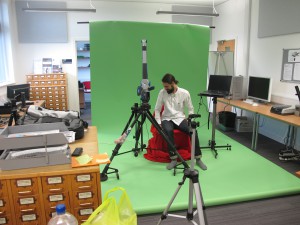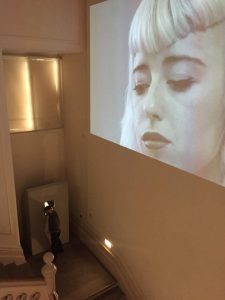May 31, 2017, by Matt Davies
James E Smith’s Model, by Nicholas Alfrey
University of Nottingham, History of Art lecturer Nicholas Alfrey revisits James E Smith’s Model as it is exhibited as part of Nottingham Castle’s Reportrait exhibition.
A striking work made by the artist James E Smith during his time as Leonardo Fellow in the Digital Humanities Centre has just gone on show again in Nottingham. James made use of the Centre’s facilities to bring new techniques to a traditional theme: the life model. The result, simply titled Model, was originally exhibited at The Collection in Lincoln during the summer of 2014, and has now been included in an exhibition examining novel approaches to portraiture at Nottingham Castle Museum (Reportrait, until 10th September 2017).
The artist has given his own account of the making of the piece, describing how he dealt with the various challenges presented by novel technologies and processes here on Digital Dialogues. But the finished work is still ambiguous and enigmatic enough to prompt some further questions.
Model is a two-part piece: a ‘sculpture’ of a nude female figure created by means of a 3D scanner and printer, and a film recording the progress of the sitting. Both parts have equal status: the film is as important as the object, not merely a record of its making. The relationship between the two parts is not immediately self-evident, though, and the spectator’s experience of the work will depend on which part is encountered first.
At the Castle, the visitor will see the 3D figure first, because it is exhibited on the staircase leading to the main galleries: a silvery, surprisingly small object, displayed in a strongly-lit recess. The precious-looking material is actually nylon dust hardened by a laser, while the small scale is determined by the process, in which a ‘point cloud’ of data is printed in three dimensions. Some passages seem perfectly formed while others are less well defined: the effect is curiously like that of certain sculptures by Rodin, in which the figure appears half-released by the marble.
The film is projected on the wall adjacent to the sculpture, but well above it, so it will most probably be the last thing a visitor will see, just before descending the staircase again. The film lasts for 100 minutes, the actual time it took to scan the model. Spectators are likely to watch only a few minutes of it, and at first may be unsure of what exactly it is they are watching. There is footage of the head and naked shoulders of a blonde girl, looking straight to camera. But her expression difficult to read: is she comfortable or ill at ease? In other sequences, a male figure stands over her, holding an object that could momentarily be mistaken for a power tool. Any suggestion of a scene from a Brian De Palma movie is misleading, of course: it is only James with his scanner, accumulating data, or sometimes inadvertently missing it, as we can see from the eventual 3D realization.
Cutting-edge technology apart, the film seems to re-enact the traditional relationship of artist and model. Indeed, James, in his white shirt, brings to mind a well-known photograph by Brassai showing Matisse in a white coat gazing intently at his model. Feminists have objected to this image of the creative, controlling male and the passive nude female. But what is going on in James’s piece is not exactly artistic business as usual. There is a more collaborative element here: the model herself has determined the protocols of the sitting and the camera positions, and the three cameras are monitored by an (unseen) woman, the artist Alice Gale-Feeny, who had been recruited to assist. Besides, James himself has not been afraid to step up when it comes to nudity for the sake of art: he took the model’s role when Roger Hiorns’ installation/performance piece Untitled was shown in the British Art Show at Nottingham Contemporary back in 2010.

DHC Leonardo Fellow James E Smith preparing for the scan/video shoot for ‘Model’.
Image by Matt Davies.
No comments yet, fill out a comment to be the first


Leave a Reply